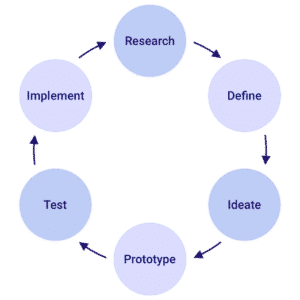How LeadDesk's research and development process works
A new blog series from Leaddesks' products team outlines how seriously we take user-centric design.

In this new blog series, we want to introduce the processes we use at LeadDesk to design and develop our software.
Our five core principles when designing the software are easy, reliable, efficient, pioneering and transparent. To support these principles, we follow the user-centered design process. It is an iterative process which involves users throughout the development cycle.

Research: The product owners and designers participate in client meetings to learn more about the needs and challenges of the users.
Define: From the discussions, we identify frequently brought up issues and the root causes. The selected ones will be prioritized according to their urgency and scope.
Ideate: The team brainstorms and discusses potential solutions.
Prototype: The designers prepare user flow and interface for the chosen solution. For more complicated feature and redesign projects, we create prototypes and a research plan to test their performances. We also consult the development team to understand the scope and limitation of the new design as well as the impact it would have on the current software.
Test: We conduct remote or live usability tests to collect feedback and discover uncertainties in the new design. Feedback from these sessions are recorded and analyzed.
Implement: Once the new design is approved, it’s sent to the development team.
Modern Outbound UI project
In 2019, we wanted to update the current Outbound software to implement the new branding and improve the usability. To ensure the quality of the new version, we conducted multiple research projects to gain a better understanding of our clients.
We organized shadowing sessions with clients in Finland to observed how users used LeadDesk in their own work environment, followed by post-session interviews to learn more about their needs and challenges. Our plan to conduct similar sessions with the international clients was delayed due to the pandemic. Instead, we opted to conduct online interviews and remote usability tests.
Based on the results from the initial research and internal discussions, in 2020, the product team started to work on a new user interface (UI). We tested a few early versions within the companies as well as with volunteered users to collect early feedback for further development.
After a few drawbacks, we finalized a complete design version. While the development team started to work on the backend, we ran more remote usability tests to gather more insights.
If you’re interested to learn more about the full research and development process of the Modern Outbound UI project, a full report can be found here Outbound UI Research.
By conducting frequent user research, we make sure LeadDesk software can satisfy the user’s needs. We’d love to share the journey with you. Please look forward to upcoming posts!
Read our other posts from this series

This is part of a series about the various projects LeadDesk’s professional consulting service (PCS) team undertake to build custom functionalities and extensions to our contact center software. Some projects are custom-built for single customers and stay that way, while others are adapted later on for more widespread use (LeadApps).

How simple button choices make a huge difference in agent experience in contact center software. Learn the latest in contact center UI design.

Say hello to LeadDesk’s new Modern Outbound UI. Learn how we built a new agent experience to improve your sales workflow.